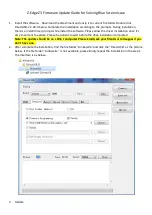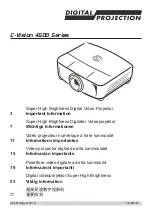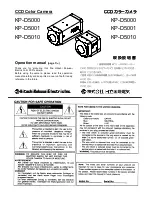
Piranha ES-xx User Manual
Teledyne DALSA
03-032-20070-02
53
1.
Analog gain is m u ltip lied by the analog signal to increase the signal strengt h before
the A/ D conversion. It is u sed to take ad vantage of the fu ll d ynam ic range of the
A/ D converter. For exam p le, in a low light situ ation the brightest p art of the im age
m ay be consistently com ing in at only 50% of the DN . An analog gain of 6 d B (2x) w ill
ensu re fu ll u se of the d ynam ic range of the A/ D converter. Of cou rse the noise is also
increased .
2.
The analog offset or black level is an ―artificial‖ offset introduced into the video path
to ensu re that the A/ D w ill fu nction p rop erly. The analog offset shou ld be set so that
it is at least 3 tim es the rm s n oise valu e at the cu rrent gain.
Digital Processing
To op tim ize cam era p erform ance, d igital signal p rocessing shou ld be com p leted after any
analog ad ju stm ents.
1.
Fixed p attern noise (FPN ) calibration (calcu lated u sing the
su btract aw ay ind ivid u al p ixel d ark cu rrent.
2.
The d igital offset (
com m and ) enables the su btraction of the ―artificial‖ A/ D offset
(the analog offset) so that ap p lication of the PRN U coefficient d oesn’t resu lt in
artifacts at low light levels d u e to the offset valu e. You m ay w ant to set the
if you are not u sing FPN correction bu t w ant to p erform PRN U correction.
3.
Photo-Resp onse N on-Uniform ity (PRN U) coefficients are u sed to correct the
d ifference in resp onsivity of ind ivid u al p ixels (i.e. given the sam e am ou nt of light
d ifferent p ixels w ill charge u p at d ifferent rates) and the change in light intensity
across the im age either becau se of the light sou rce or d u e to op tical aberrations (e.g.
there m any be m ore light in the center of the im age). PRN U coefficients are
m u ltip liers and are d efined to be of a valu e greater than or equ al to 1. This ensu res
that all p ixels w ill satu rate tog ether. When u sing PRN U correction, it is im p ortant
that the A/ D offset and Fixed Pattern N oise (FPN ) or p er p ixel offsets are su btracted
p rior to the m u ltip lication by the PRN U coefficient. The su btraction of these 2
com p onents ensu re that the vid eo su p p lied to the PRN U m u ltip lier is nom inally zero
and zero m u ltip lied by anything is still zero resu lting in no PRN U coefficient ind u ced
FPN . If the offset is not su btracted from the vid eo then there w ill be artifacts in the
vid eo at low light cau sed by the m u ltip lication of the offset valu e by the PRN U
coefficients.
4.
Backgrou nd su btract (
com m and ) and system (d igital) gain (
u sed to increase im age contrast after FPN and PRN U calibration. It is u sefu l for
system s that p rocess 8-bit d ata bu t w ant to take ad vantage of the cam era’s 12-bit
d igital p rocessing chain. For exam p le, if you find that you r im age is consistently
betw een 128 and 255DN (8-bit), you can su btract off 128 (
ssb 2048
) and then
m u ltip ly by 2 (
ssg 0 8192
) to get an ou tp u t range from 0 to 255.
The follow ing sections are organized as follow s:
1.
Section Analog Signal Processing p rovid es a d etailed d escrip tion of all analog
p rocessing chain com m and s.
2.
Section Calibrating the Cam era to Rem ove N on -Uniform ity (Flat Field
Correction) p rovid es an overview of how to p erform flat field calibration.
3.
Section Digital Signal Processing p rovid es a d etailed d escrip tion of all d igital
p rocessing chain com m and s.
Summary of Contents for Piranha ES Series
Page 22: ...Piranha ES xx User Manual 03 032 20070 02 Teledyne DALSA 22 ...
Page 88: ...Piranha ES xx User Manual 03 032 20070 02 Teledyne DALSA 88 ...
Page 102: ...Piranha ES xx User Manual 03 032 20070 02 Teledyne DALSA 102 ...
Page 104: ...Piranha ES xx User Manual 03 032 20070 02 Teledyne DALSA 104 ...















































